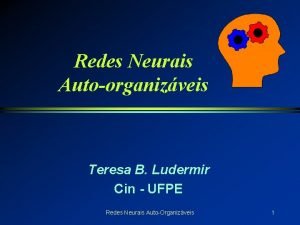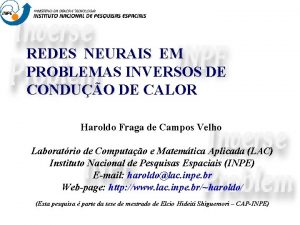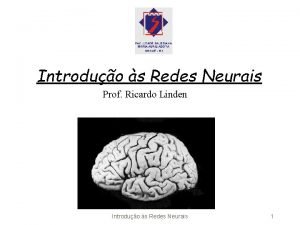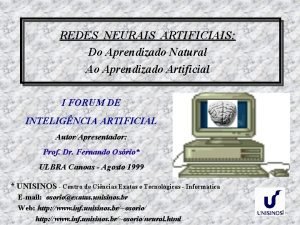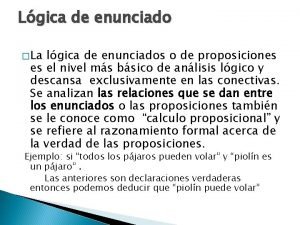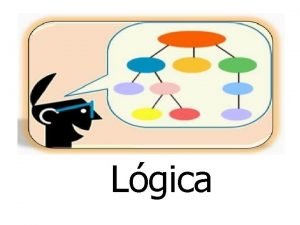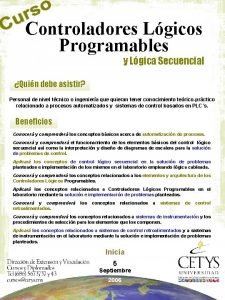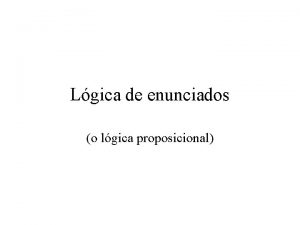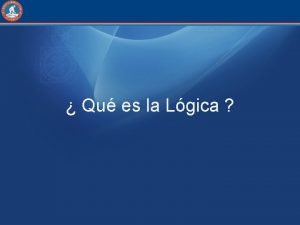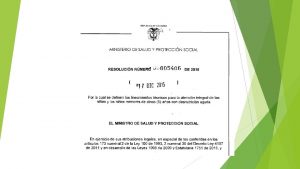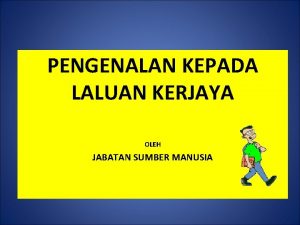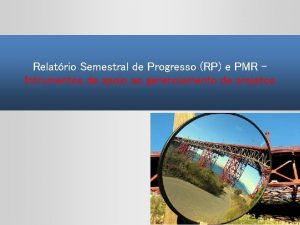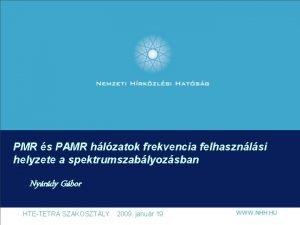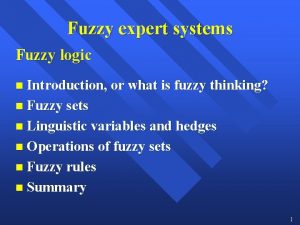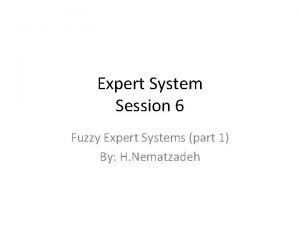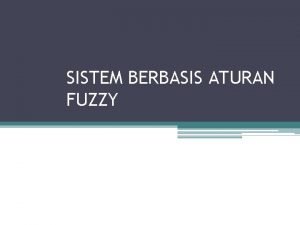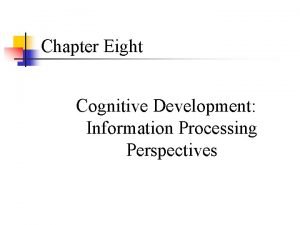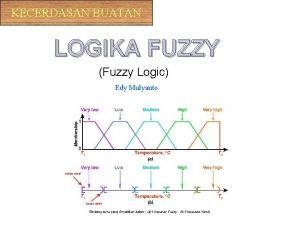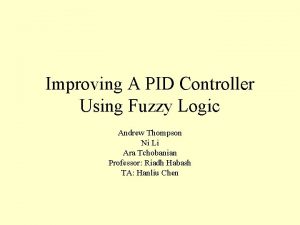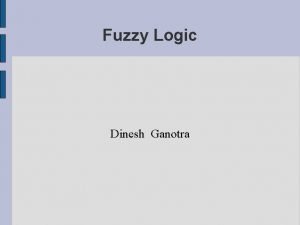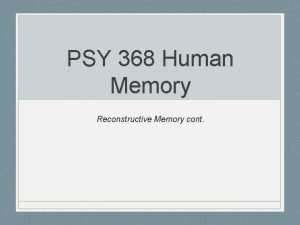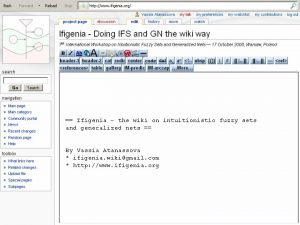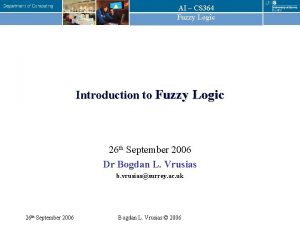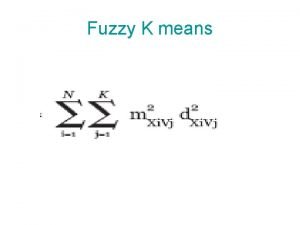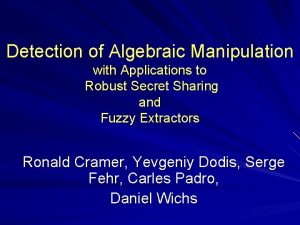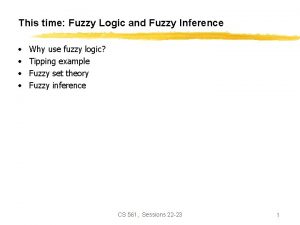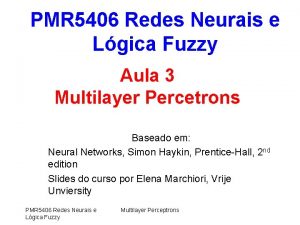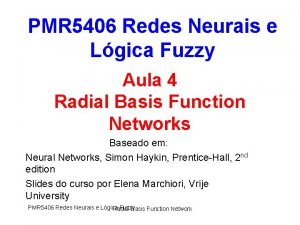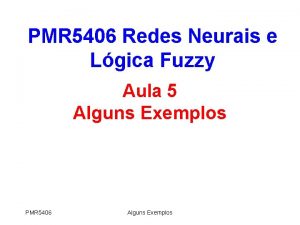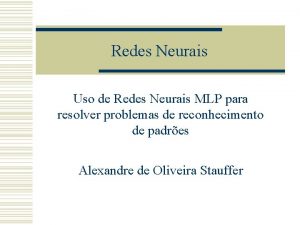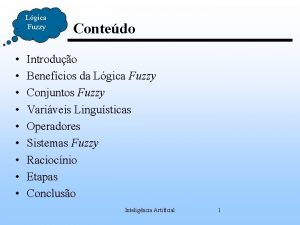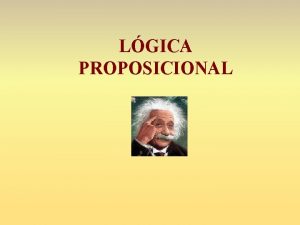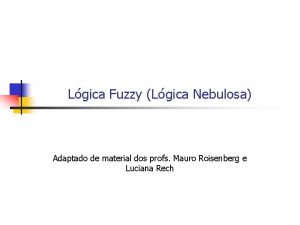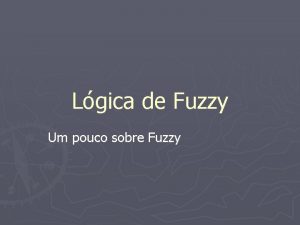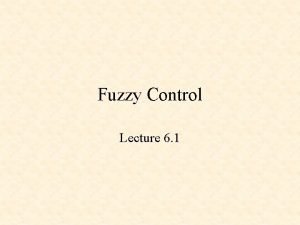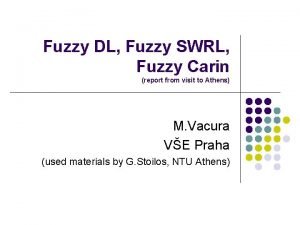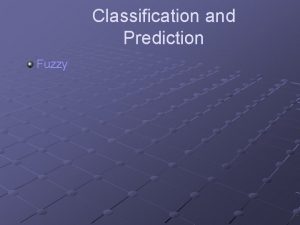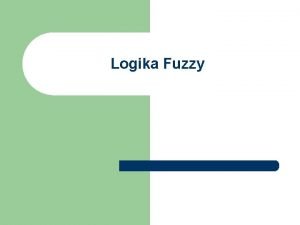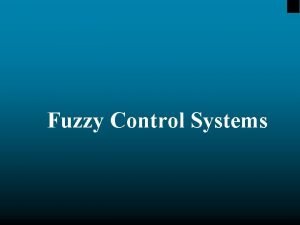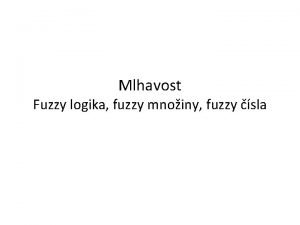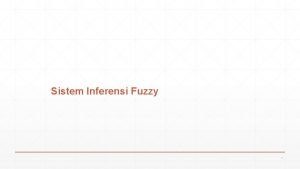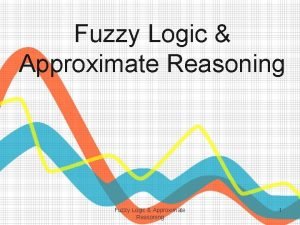PMR 5406 Redes Neurais e Lgica Fuzzy Aula






































- Slides: 38

PMR 5406 Redes Neurais e Lógica Fuzzy Aula 9 – Self. Organising Maps Baseado em: Neural Networks, Simon Haykin, Prentice-Hall, 2 nd edition Slides do curso por Marchiori PMR 5406 Redes Neurais e Lógica Fuzzy SOM

Unsupervised Learning • Neural networks for unsupervised learning attempt to discover special patterns from available data without using external help (i. e. RISK FUNCTION). – There is no information about the desired class (or output ) d of an example x. So only x is given. – Self Organising Maps (SOM) are neural network models for unsupervised learning, which combine a competitive learning principle with a topological structuring of neurons such that adjacent neurons tend to have similar weight vectors. PMR 5406 Redes Neurais e Lógica Fuzzy SOM 2

SOM: Biological Motivation • Neurobiological hypothesis: – The structure self-organises based on learning rules and system interaction. – Axons physically maintain neighborhood relationships as they grow. PMR 5406 Redes Neurais e Lógica Fuzzy SOM 3

Topographic maps – Somatotopic map: projection of body surface onto a brain area, called somatosensory cortex, responsible for sense of touch. – Motor map: Is similar for movement commands instead of touch. – Retinotopic map: Is for vision. The area is called superior colliculus. – Phonotopic map: Is for hearing: the auditory cortex. PMR 5406 Redes Neurais e Lógica Fuzzy SOM 4

The cytoarchitectural map PMR 5406 Redes Neurais e Lógica Fuzzy SOM 5

The cytoarchitectural map PMR 5406 Redes Neurais e Lógica Fuzzy SOM 6

Two self-organised maps PMR 5406 Redes Neurais e Lógica Fuzzy SOM 7

ARCHITECTURE • The input is connected with each neuron of a lattice. • Lattice Topology: It determines a neighbourhood structure of the neurons. 1 -dimensional topology A small neighbourhood 2 -dimensional topology Two possible neighbourhoods PMR 5406 Redes Neurais e Lógica Fuzzy SOM 8

Two-dimensional lattice Layer of source nodes PMR 5406 Redes Neurais e Lógica Fuzzy SOM 9

The goal • We have to find values for the weight vectors of the links from the input layer to the nodes of the lattice, in such a way that adjacent neurons will have similar weight vectors. • For an input, the output of the neural network will be the neuron whose weight vector is most similar (with respect to Euclidean distance) to that input. • In this way, each (weight vector of a) neuron is the center of a cluster containing all the input examples which are mapped to that neuron. PMR 5406 Redes Neurais e Lógica Fuzzy SOM 10

The learning process (1) An informal description: • Given: an input pattern x • Find: the neuron i which has closest weight vector by competition (wi. T x will be the highest). • For each neuron j in the neighbourhood N(i) of the winning neuron i: – update the weight vector of j. PMR 5406 Redes Neurais e Lógica Fuzzy SOM 11

The learning process (2) • Neurons which are not in the neighbourhood are left unchanged. • The SOM algorithm: – Starts with large neighbourhood size and gradually reduces it. – Gradually reduces the learning rate . PMR 5406 Redes Neurais e Lógica Fuzzy SOM 12

The learning process (3) – Upon repeated presentations of the training examples, the weight vectors tend to follow the distribution of the examples. – This results in a topological ordering of the neurons, where neurons adjacent to each other tend to have similar weights. PMR 5406 Redes Neurais e Lógica Fuzzy SOM 13

The learning process (4) • There are basically three essential processes: – competition – cooperation – weight adaption PMR 5406 Redes Neurais e Lógica Fuzzy SOM 14

The learning process (5) • Competition: – Competitive process: Find the best match of input vector x with weight vectors: total number of neurons winning neuron – The input space of patterns is mapped onto a discrete output space of neurons by a process of competition among the neurons of the network. PMR 5406 Redes Neurais e Lógica Fuzzy SOM 15

The learning process (6) • Cooperation: – Cooperative process: The winning neuron locates the center of a topological neighbourhood of cooperating neurons. – The topological neighbourhood depends on lateral distance dji between the winner neuron i and neuron j. PMR 5406 Redes Neurais e Lógica Fuzzy SOM 16

Learning Process (7) - neighbourhood function – Gaussian neighbourhood function hi 1. 0 2σ 0 PMR 5406 Redes Neurais e Lógica Fuzzy dji SOM 17

Learning process (8) – (effective width) measures degree to which excited neurons in the vicinity of the winning neuron participate to the learning process. exponential decay update time constant – dji: lateral distance • in one dimension lattice || j – i || • in two dimension lattice || rj - ri || rj is the position of neuron j in the lattice. PMR 5406 Redes Neurais e Lógica Fuzzy SOM 18

Learning process (9) • Applied to all neurons inside the neighbourhood of the winning neuron i. Hebbian term forgetting term scalar function of response yj exponential decay update: PMR 5406 Redes Neurais e Lógica Fuzzy SOM 19

Two phases of weight adaption • Self organising or ordering phase: – Topological ordering of weight vectors. – May take 1000 or more iterations of SOM algorithm. • Important choice of parameter values: – (n): 0 = 0. 1 T 2 = 1000 decrease gradually (n) 0. 01 – hji(x)(n): 0 big enough T 1 = 1000 log ( 0) – Initially the neighbourhood of the winning neuron includes almost all neurons in the network, then it shrinks slowly with time. PMR 5406 Redes Neurais e Lógica Fuzzy SOM 20

Two phases of weight adaption • Convergence phase: – Fine tune feature map. – Must be at least 500 times the number of neurons in the network thousands or tens of thousands of iterations. • Choice of parameter values: – (n) maintained on the order of 0. 01. – hji(x)(n) contains only the nearest neighbours of the winning neuron. It eventually reduces to one or zero neighbouring neurons. PMR 5406 Redes Neurais e Lógica Fuzzy SOM 21

A summary of SOM • Initialization: choose random small values for weight vectors such that wj(0) is different for all neurons j. • Sampling: drawn a sample example x from the input space. • Similarity matching: find the best matching winning neuron i(x) at step n: • Updating: adjust synaptic weight vectors • Continuation: go to Sampling step until no noticeable changes in the feature map are observed. PMR 5406 Redes Neurais e Lógica Fuzzy SOM 22

Example 1 A 2 -dimensional lattice driven by a 2 -dimensional distribution: • 100 neurons arranged in a 2 D lattice of 10 x 10 nodes. • Input is bidimensional: x = (x 1, x 2) from a uniform distribution in a region defined by: { (-1 < x 1 < +1); (-1 < x 2 < +1) } • Weights are initialised with random values. PMR 5406 Redes Neurais e Lógica Fuzzy SOM 23

Visualisation • Neurons are visualised as changing positions in the weight space (which has the same dimension of the input space) as training takes place. PMR 5406 Redes Neurais e Lógica Fuzzy SOM 24

Example 1: results PMR 5406 Redes Neurais e Lógica Fuzzy SOM 25

Example 2 A one dimensional lattice driven by a two dimensional distribution: • 100 neurons arranged in one dimensional lattice. • Input space is the same as in Example 1. • Weights are initialised with random values (again like in example 1). • (Matlab programs for Examples 1, 2 available at ftp: //ftp. mathworks. com/pub/books/haykin) PMR 5406 Redes Neurais e Lógica Fuzzy SOM 26

Example 2: results PMR 5406 Redes Neurais e Lógica Fuzzy SOM 27

Example 2: parameter evolution PMR 5406 Redes Neurais e Lógica Fuzzy SOM 28

Learning Vector Quantisation (1) • Vector quantisation is a technique designed for data compression. • A vector quantiser with minimum encoding distortion is a called a Voronoi or neares-neighbour quantiser. PMR 5406 Redes Neurais e Lógica Fuzzy SOM 29

Learning Vector Quantisation (2) • Learning Vector Quantisation (LVQ) is a supervised learning technique that move the Voronoi vectors slightly. So as to improve the quality of the classifier decision regions. • It can be devided into two parts: a competitive layer and a vector quantisation layer: PMR 5406 Redes Neurais e Lógica Fuzzy SOM 30

Learning Vector Quantisation (3) • The algorithm: – Let {wj}j=1 l denote the Voronoi vectors and let {xi}i=1 N the input vectors. – Cwc is the class associated with wc. Cwi is the class associated with wi. 1. If Cwc= Cwi then: Wc(n+1) = wc(n) + αn [xi - wc(n)] 2. If Cwc<> Cwi then: Wc(n+1) = wc(n) - αn [xi - wc(n)] 3. The other Voronoi vectors are not modified. PMR 5406 Redes Neurais e Lógica Fuzzy SOM 31

Learning Vector Quantisation (4) • Um exemplo: PMR 5406 Redes Neurais e Lógica Fuzzy SOM 32

Acoustic Transmission System for Oil-Well Monitoring receiver • • • Periodic measurement of temperature and pressure at the downhole. Column length used in deepsea exploration might be ordinarily longer than 3, 000 m. With the elimination of cabling significant cost savings and increased reliability can be attained. PMR 5406 Redes Neurais e Lógica Fuzzy Sea surface Jacket Pipeline Thread joint Sea bottom downhole SOM Temperature, pressure sensors, transmitter 33

• • Some important issues: – Multiple reflections take place at the pipeline junctions, – Propagation through thread joints introduces nonlinear characteristics, – The oil flow produces vibration therefore being a source of acoustic noise. The chosen solution: – Frequency-Shift Keying (FSK) modulation is chosen, I. e. , a frequency f 1 is chosen for a bit “ 1” and a frequency f 2 is chosen for a bit “ 0” – Demodulation process using a Linear Vector Quantization based Neural Network PMR 5406 Redes Neurais e Lógica Fuzzy SOM 34

• • u(k)=f(k) v(k)=f(k+l) A histogram matrix H(u, v) is designed. A geometric series generator was used to compress histogram peaks and reinforce other points of the image: • Z(u, v)=(1 -0. 5 H(u, v))/(1 -0. 5). PMR 5406 Redes Neurais e Lógica Fuzzy SOM 35

PMR 5406 Redes Neurais e Lógica Fuzzy SOM 36

How FSK frequencies are selected ? • • • The acoustic waves propagating on such mechanical structure has phase and group velocities depending on frequency, Some frequencies are blocked for propagation within certain periodic bands, Therefore, the acoustic waves propagates at the expense of high distortion of phase and group velocities in terms of frequency, Transducer(wellhead) Threaded tool joint d 2, a 2 PMR 5406 Redes Neurais e Lógica Fuzzy SOM pipe Transducer(downhole) d 1, a 1 37

• · The relationship between the angular frequency and the wave number k is given by: Extensional wave velocity in steel Phase velocity Group velocity PMR 5406 Redes Neurais e Lógica Fuzzy SOM 38
 Color 03062003
Color 03062003 Redes neurais
Redes neurais Fuzzy sets and fuzzy logic theory and applications
Fuzzy sets and fuzzy logic theory and applications Imagens de sinapses neurais
Imagens de sinapses neurais Imagens de sinapses neurais
Imagens de sinapses neurais Lgica
Lgica Lgica
Lgica Lgica
Lgica Lgica
Lgica Lgica
Lgica Lgica
Lgica Razonamiento proposicional ejemplos
Razonamiento proposicional ejemplos Lgica
Lgica 5406
5406 Apa itu pmr
Apa itu pmr Tribakti pmr
Tribakti pmr Pengenalan kerjaya
Pengenalan kerjaya Pmr bid
Pmr bid Milwaukee shoulder syndrome
Milwaukee shoulder syndrome Definisi pmr
Definisi pmr Pmr sávok
Pmr sávok Pmr
Pmr Fuzzy expert systems
Fuzzy expert systems Fuzzy search mysql
Fuzzy search mysql Fuzzy expert system
Fuzzy expert system Blok fuzzy sistem
Blok fuzzy sistem Um expert
Um expert Cognitive information processing theory
Cognitive information processing theory Sugeno
Sugeno Crisp relation definition
Crisp relation definition Fuzzy logic
Fuzzy logic Dinesh ganotra
Dinesh ganotra Fuzzy front end
Fuzzy front end Fuzzy traces
Fuzzy traces Wiki
Wiki What is linguistic variables in fuzzy logic
What is linguistic variables in fuzzy logic Fuzzy k means
Fuzzy k means Fuzzy extractor
Fuzzy extractor Fuzzy logic
Fuzzy logic
